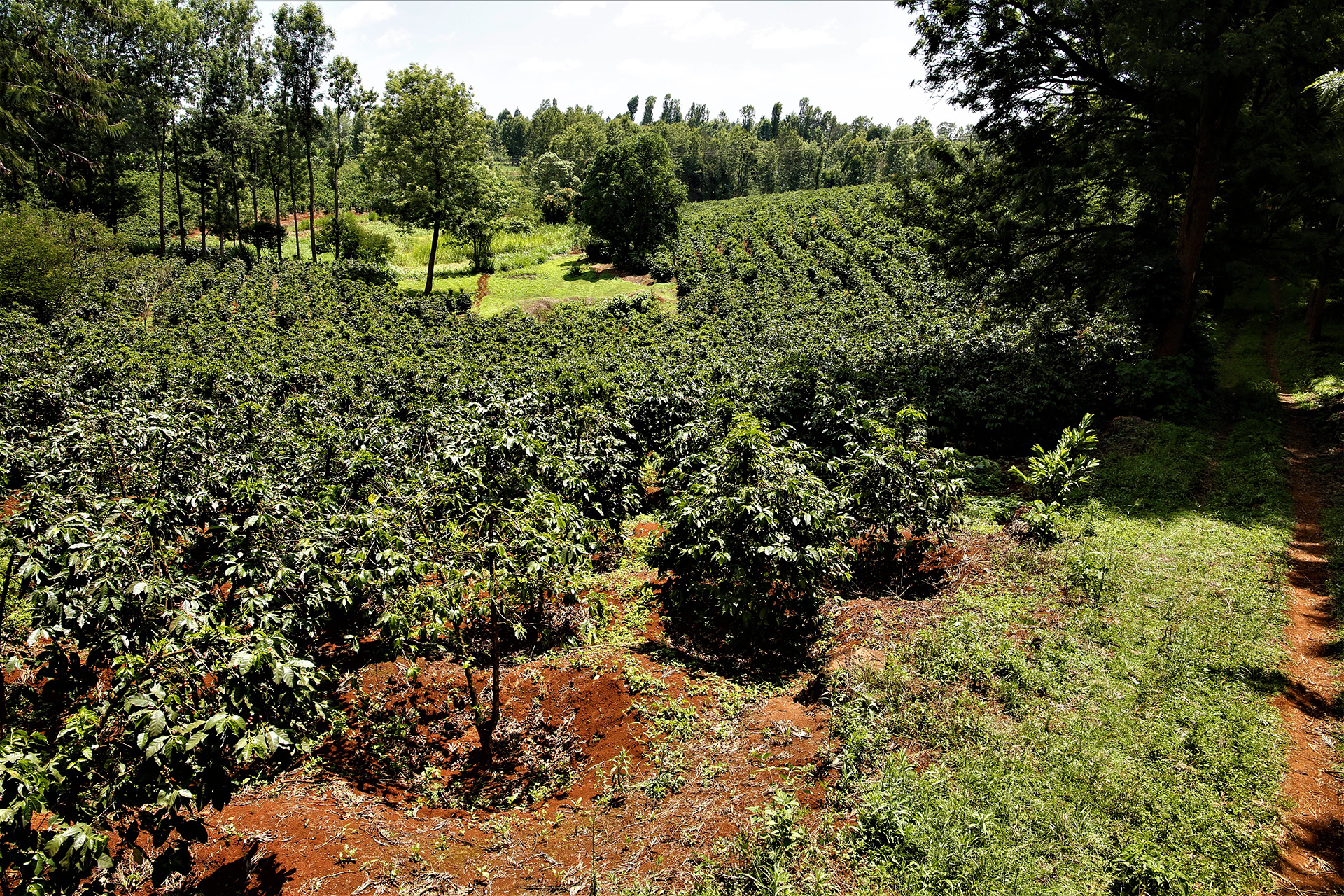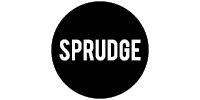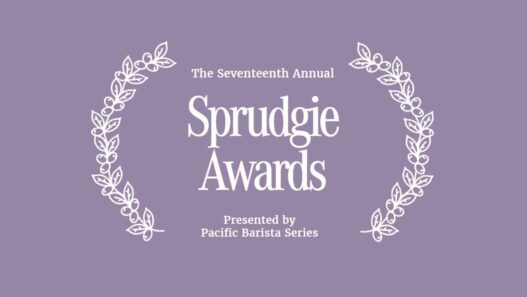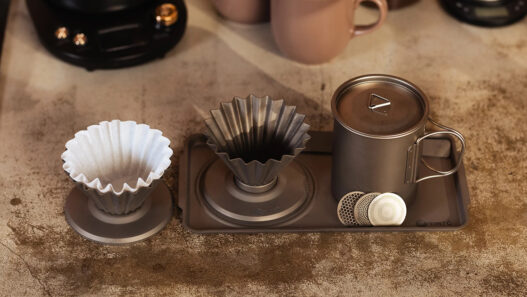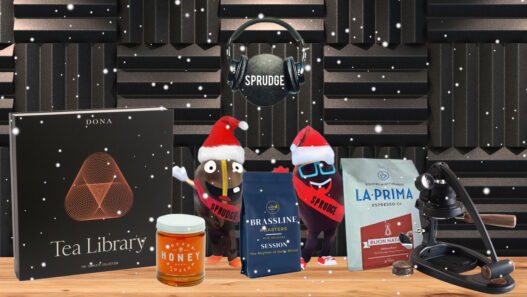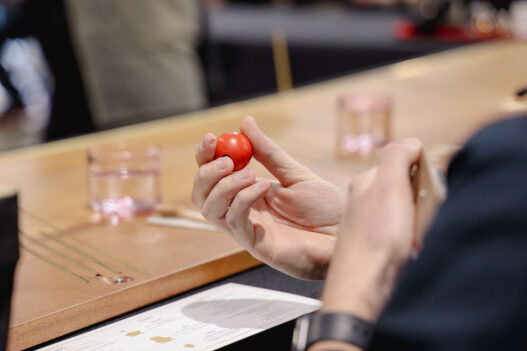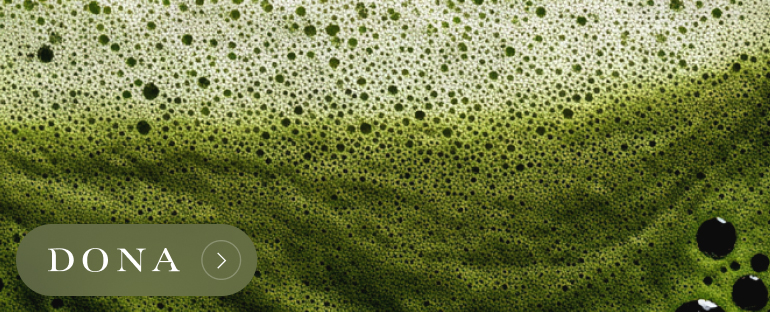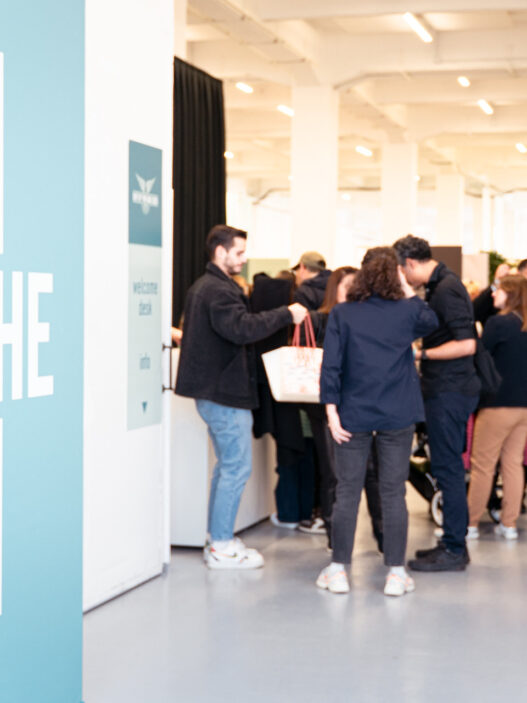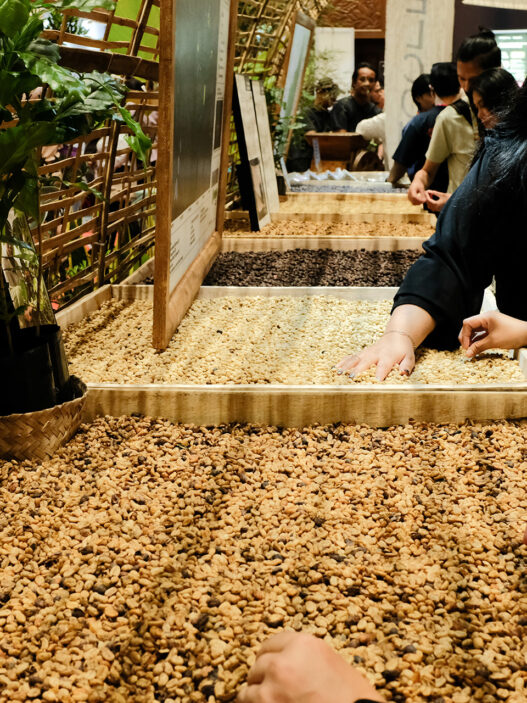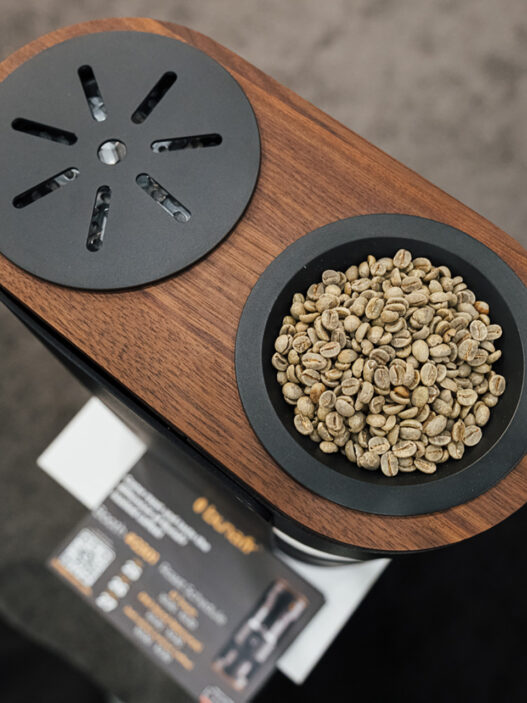Welcome back to the Black & White Coffee Roasting HQ in Raleigh, North Carolina for more 2025 US Barista Championship action! Day Two, the Semi-Finals. Things are starting to get interesting. 12 competitors fought their way through Round One yesterday for a chance to perform again today. This time, though, they’ll be met by the six baristas who earned a bye into the Semis by placing in the top three at one of the two Regional events. And making the cut this time is going to be even harder.
Only six competitors will move onto tomorrow’s Finals rounds; that’s less than one in three. So if it wasn’t already, now it’s A-game time. But these baristas are ready. They’re styled, their espresso’s dialed, and their roast is profiled. We’ll be here all day live recapping each and every competitor’s routine, which we will be regularly updating in this very articles that your eyeballs are perusing at this very moment. Buckle up, everybody, the action is only getting started.
Sprudge’s coverage of the 2025 US Barista Championship in Raleigh, North Carolina is presented in by La Marzocco and Pacific Barista Series.
Christian Ortega – Olympia Coffee Roasters – Seattle, WA

“Taste is a time machine. One sip has the power to transport us,” Christian Ortega tells the judges to begin his routine. Ortega was the second competitor yesterday and now has the honor of leading off the entire shebang today. He competes with an anaerobic fermented, natural processed Gesha variety grown at 1,700MASL in San Sebastian, Colombia by the Gutierrez family. Really cool espresso service from Ortega here, who pulls his shots into frozen cups to trap in the volatile aromatic compounds, which he then decants in a wine glass, releasing those trapped compounds right before the judges get to taste. Catch and release baby. 19g in and 47g out in just 19 seconds for notes of mango juice, meyer lemon peel, and oolong tea.
For the milk course, Ortega combines 81% freeze distilled lactose-free milk, 16% oat milk, and 3% cryodesiccated coconut milk, which has notes of Lucky Charms marshmallows and strawberry candy. For the sig bev, Ortega has crafted a cafe de olla- and arroz con leche-inspired beverage that “transports him back to his abuelita’s kitchen.” He describes the beverage as a drinking custard. “Judges, if you lips stick to the cup, welcome to my childhood.” A rice and toasted almond-infused evaporated milk, Mexican sugar and cinnamon syrups, and an N/A bitters all get combined and frothed together for flavors of snickerdoodle cookie, amaretto, and a drinking yogurt tang.
Tyler Montague – Brew Coffee Bar – Raleigh, NC
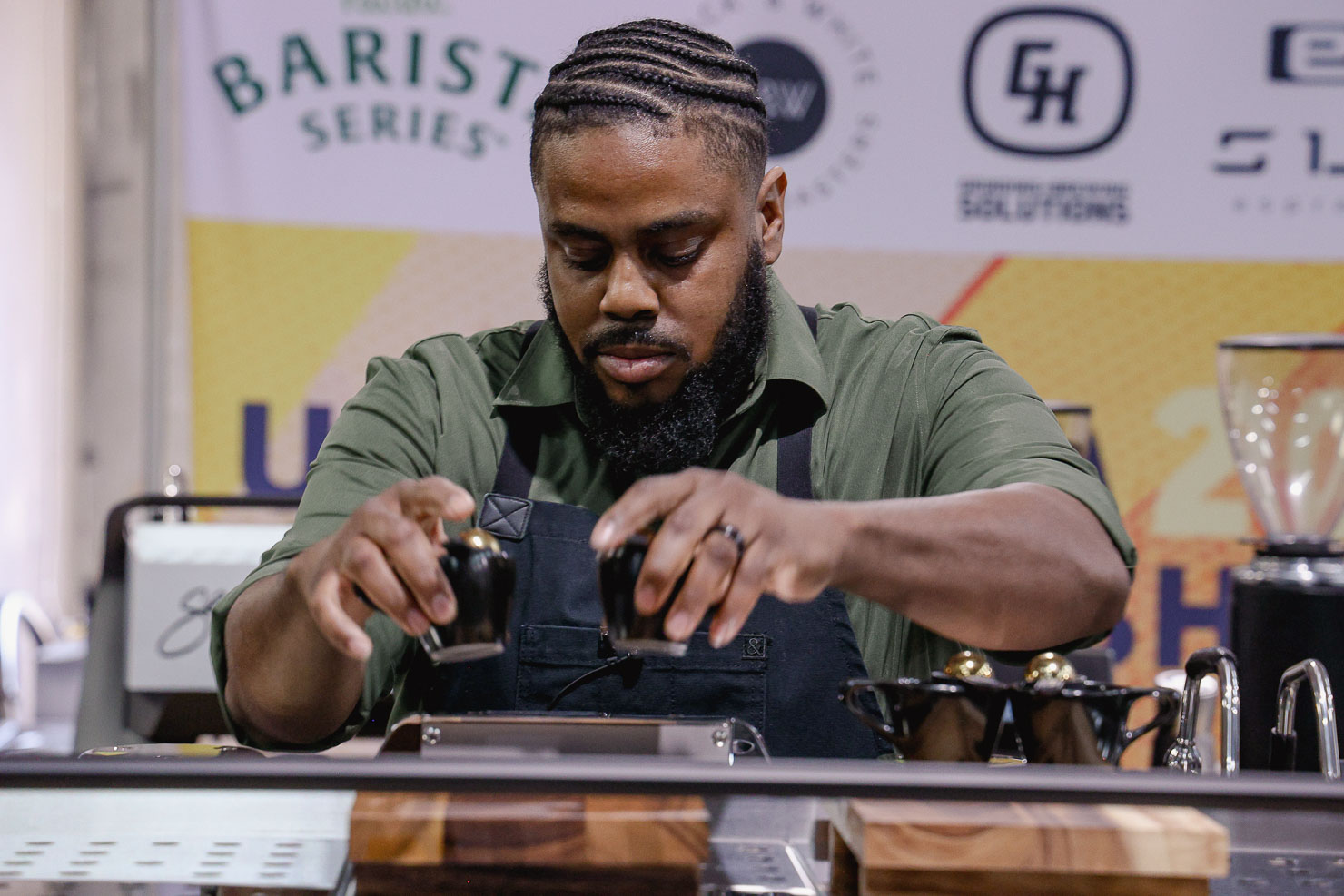
Now up is Tyler Montague of Brew Coffee Bar here in Raleigh. Montague starts with the milk course, which we’ve seen a lot of competitors do this year. I’ll be honest, it seemed a little risky to me, especially with how coating that particular course can be to the palate, but that’s probably why I’m back here and they’re up there.
Using a 1:1 blend of freeze-distilled milk down to 25% by weight and whole milk, Montague combines an anaerobic fermented natural processed from Kenya, pulled at 19g in to 40g out, for notes of apricot jam, butterscotch, milk chocolate, and baking spice. Coffees from Kenya don’t get enough love in Barista comps IMO. (So rare that I remember a Jenna Gotthelf routine from a few years back simply by its inclusion of a Kenya.) Sure, they can be tricky as espresso, but when done right, they are transcendent. No half measures at USBC, you gotta go for it!
As espresso, Montague’s Kenya espresso pulled over frozen spheres presents flavors of raspberry, baking spice, and dark chocolate. In the sig bev, charred fresh mango and quinine syrup, a citrus spice blend of star anise, all spice, clove, black peppercorn, blood orange, lemon, lime, and charred grapefruit, an oleo saccharum from the peels of the fruits from the citrus spice blend, and water to open up the drink, all get combined, nitro charged and served in cairn glasses, giving the drink notes of fresh squeezed navel orange juice and cherry cola.
Brooks Berdeen – Union Coffee Greensboro – Greensboro, NC

We’re staying in North Carolina but heading about 70 miles west for our next competitor, Brooks Berdeen of Union Coffee in Greesnboro. Berdeen is both a barista and an accomplished engineer, and his routine today is about the dichotomy of art and science, to which he posits: can’t it be both?
Berdeen competes today with an aerobic fermented Sakura Sidra Gesha produced by Julio Madrid and processed by Julio Quinceno in Colombia, and roasted by Black & White. Berdeen pulls the espressos for every course using the same parameters: 19.2g in and 42g out in 25 seconds. After pulling and hyper-chilling shots that will be used for his espresso course later, Berdeen lays down his first round of drinks, the espresso, which have notes of white florals like lychee, orange, and chocolate.
For the milk course, 1:3 ratio drink, Berdeen uses a double freeze-distilled lactose-free milk that transforms the notes in the Sakura Gesha to those of rose, vanilla, and chocolate, “reminiscent of a sweet milk tea,” he tells the judges. For his sig bev, Berdeen combines those chilling espressos hibiscus tea, mango juice, rice milk, and compressed coconut water. A nitrogen infusion ups the decadence and textural elements, giving the flavors of jasmine tea, guava, and sweet cream.
Christian Gutierrez – Moongoat Coffee Roasters – Costa Mesa, CA

“The true beauty of coffee is its ability to take many shapes and forms. There’s no one way,” Christian Gutierrez tells the judges. For his routine day, Gutierrez takes inspiration from his Mexican identity to parse out the three courses: music (espresso), culture (milk), and tradition (the sig bev). He uses an anaerobic fermented Bourbon-Sidra produced by Julio Madrid in Risaralda, Colombia. As an espresso, it has notes of pomelo, raspberry, blood orange, green grape, and a cacao nib bitterness and a floral jasmine finish.
Moving on to the milk beverage, Gutierrez uses a blend of 40% freeze-distilled lactose-free milk and 60% A2 whole milk, combined in a 2:3 ratio, giving his beverage flavors of yogurt candy, guava Danish, and chocolate pudding. For his sig bev, Gutierrez begins with a traditional cafe de olla recipe that he then brings his own touches to. Piloncillo syrup—made from an unrefined Mexican brown sugar—and cinnamon and star anise simple syrup get added to a 90/10 mix of A2 and freeze-distilled milks from the prior course, which all get steamed together and combined with the Bourbon-Sidra for notes of caramel and licorice. The sig bev is the course about tradition, and while he is referring primarily to his Mexican heritage, is there any greater cafe tradition than a flavored latte, which is what Gutierrez’s sig bev is here today, which I mean with a great deal of respect and sincerity.
Isaiah Sheese – Archetype Coffee – Omaha, NE

Now up is 2023 US Barista Champion Isaiah Sheese. “Connection, we need it,” he tells the judges, and today he’ll be making connections between two different coffees, both of which were grown at 1,800MASL in Huila, Colombia, but different varieties grown by different producers. The first, which he’ll use in both the sig bev and milk course, is an Advanced processed Ombligon variety grown by Edinson Argote at La Quebradita. The second is a wash processed Pink Bourbon from Lucy Fernanda Galindez at the La Muralla coop.
For the sig bev, Sheese uses the Ombligon to mimic the flavors of the Pink Bourbon. Freeze-distilled orange juice, water used specifically to brew the the Pink Bourbon, heavy butter fat milk, and egg white powder get combined and garnished with freeze-dried raspberries for notes of blood orange vanilla creamsicle, fruity pebbles, and chocolate covered strawberries.

The milk beverage, still using the Ombligon, served in a 4oz drink has notes of strawberry, milk chocolate, and creamy butterscotch. For the espresso course, Sheese creates a 50/50 blend of Ombligon and Pink Bourbon for flavors of tart ripe raspberry, soft rose, and a 70% dark chocolate finish.
Dakota Graff – Onyx Coffee Lab – Rogers, AR

Now up is Dakota Graff of Onyx Coffee Lab. Graff is the first competitor today who earned a bye directly into the Semis, which means it’s the first all-new routine we’ve seen today. He competes with a washed Elida Gesha grown at 1,800MASL by Wilford Lamastus at the Lamastus Family Estates in Panama. It has been aerobically fermented, dried in a dark room to shield the coffee from UV exposure and extending the drying time to 16 days, which opens us the floral notes and enhances the fruit flavors. Pulled at 19.5g in and 40g out in 25 seconds and compound chilled, as an espresso it has notes of orange, strong florals like honeysuckle and rose, clean, refined, and slightly tart on the finish.
“As an industry, it sometimes feels like we conflate novelty with quality.”
For the milk course, Graff uses a lactose-free freeze-distilled milk that gives his drink flavors of honey, vanilla, and milk chocolate. His final course, the sig bev, Graff combines Gesha flower and cascara tea, cascara cordial, lightly fermented milk byproduct, and soy lechtin for texture, for notes of orange, honeydew melon, vanilla, and a light caramel.
Noel Goodwin – Hagen Coffee Roasters – Seattle, WA

Semi-Finalists gonna Semi-Final, and that’s what returning Semi-Finalist Noel Goodwin is doing today… at the Semi-Finals. She competes today with a Sidra variety coffee that is the “quintessence of innovation,” she tells the judges, grown at 1,800MASL at El Vergel in Tolima, Colombia. It’s been mosto yeast anaerobic fermented—which brings about a higher sugar content in the green coffee—and natural processed. As an espresso, which is served at precisely 45C—that Goodwin uses a thermometer gun to measure (what happens if the drink drops below 45? Is there a microwave around here anywhere?—pulled at 20g in to 45g out, the Sidra has flavors of pomegranate, green grape, blackberry, and dark chocolate.

Onto the milk course, Goodwin combines a macadamia milk and a double freeze-distilled milk reduced to 30% by volume in a 1:2 ratio to create flavors of red velvet, cookies and cream, and caramel, with a creamy mouthfeel and a lingering sweet caramel finish. Moving to the signature beverage, Goodwin combines a pomegranate reduction, blackberry oleo saccharum, dehydrated pineapple-infused water, torched lemon juice, and Sidra, served over a chilled metal cube (to chill without diluting) for notes of molasses, rainier cherry, Riesling wine, and sweet orange.
Cory Sponsler – The Coffee Movement – San Francisco, CA

“The past, present, and future don’t always line up in the same trajectory, but they do inform each other,” Cory Sponsler of The Coffee Movement in San Francisco tells the judges to open his routine. He competes with a 100-hour nitrogen macerated, natural processed Green Tip Gesha produced by Jamison Savage at 1,900MASL at Finca Deborah in Volcán, Panama.
It makes my old coffee person heart happy to see Sponsler making minor tweaks to his espresso recipe from yesterday to today. 19g:45g in 25 seconds has become 19g:43g in 27 seconds. This sort of adjustment felt like a staple of an older generation of coffee competition but hasn’t been seen as much in recent years. You love to see it. That Green Tip Gesha has notes of juicy passionfruit, papaya, tannic red wine, bergamot citrus, and a creamy 65% dark chocolate finish.
For the milk course, Sponsler uses a 1:3 ratio of fresh cream top milk to freeze-distilled lactose free milk that he finishes with a toasted freeze dried non-fat milk powder. In a 3:1 blend with the Gesha, his drink tastes like melted Cherry Garcia ice cream, brown butter toffee, and a nostalgic chocolate malt Ovaltine. Moving now to the sig bev, Sponsler’s drink includes a pineapples and blueberries fermented with a strawberry probiotic yogurt in a nitrogenated environment, lemongrass tonic water, Gesha filter coffee, and Gesha espresso, all aerated to incorporate and served just below room temp. It has a fresh mint aroma up front, followed by notes of juicy blackberry, sangria, and a deep purple violet florality and a return of the mint in the finish.
Kay Cheon – Dune Coffee Roasters – Santa Barbara, CA
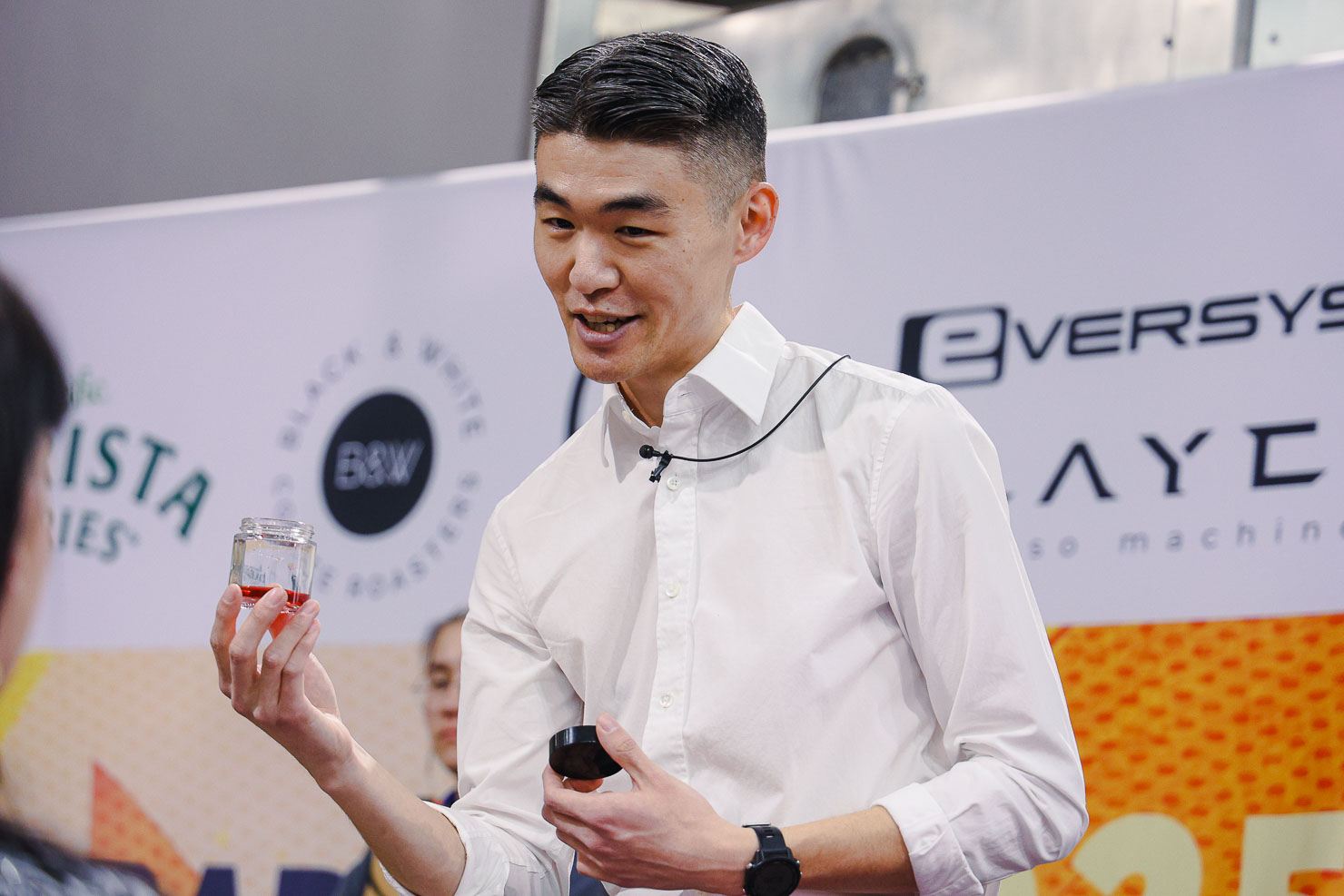
Next up to the stage is one of the favorites to take it all down this year, Kay Cheon of Dune Coffee. Cheon is a multi-time Finalist and last year’s Runner-Up. In as much as there are guarantees at the USBC, which there aren’t, Kay Cheon to Sunday can be written in pen. Cheon competes with two coffees today, a yeast-inoculated and thermal shocked Omligon produced by Nestor Lasso at Final El Diviso in Colombia, and a yeast-inoculated wash processed Green Tip Gesha from Jamison Savage at Finca Deborah in Volcan, Panama.
For the milk course, Cheon opts for the Ombligon, which he pais with what he calls “Super Milk,” a 3:1:1 blend of full cream dairy, cashew milk, and pistachio milk, all of which get roto-vacced for extra sweetness, creaminess, and smoothness. It gives the drink flavors of cherry, malted chocolate, marzipan, and vanilla. Moving to the sig bev (and sticking with the Ombligon), Cheon combines jasmine nectar, cold brew hibiscus tea, a bergamot, vanilla, and all spice distillation with his espresso for flavors of raspberry, apricot, and blood orange.
Wanna know why Cheon is always so successful at USBC? He’s an absolute technician on stage. He’s BaristaBot5000. So cool and collected, never rushed and always in complete control.
For his last course, the espressos, Cheon layers 15g of El Diviso with 5g of Finca Deborah, giving the drink notes of cherry, tangerine, and orange blossom.
Jak Ryan – Proud Mary Coffee – Austin, TX
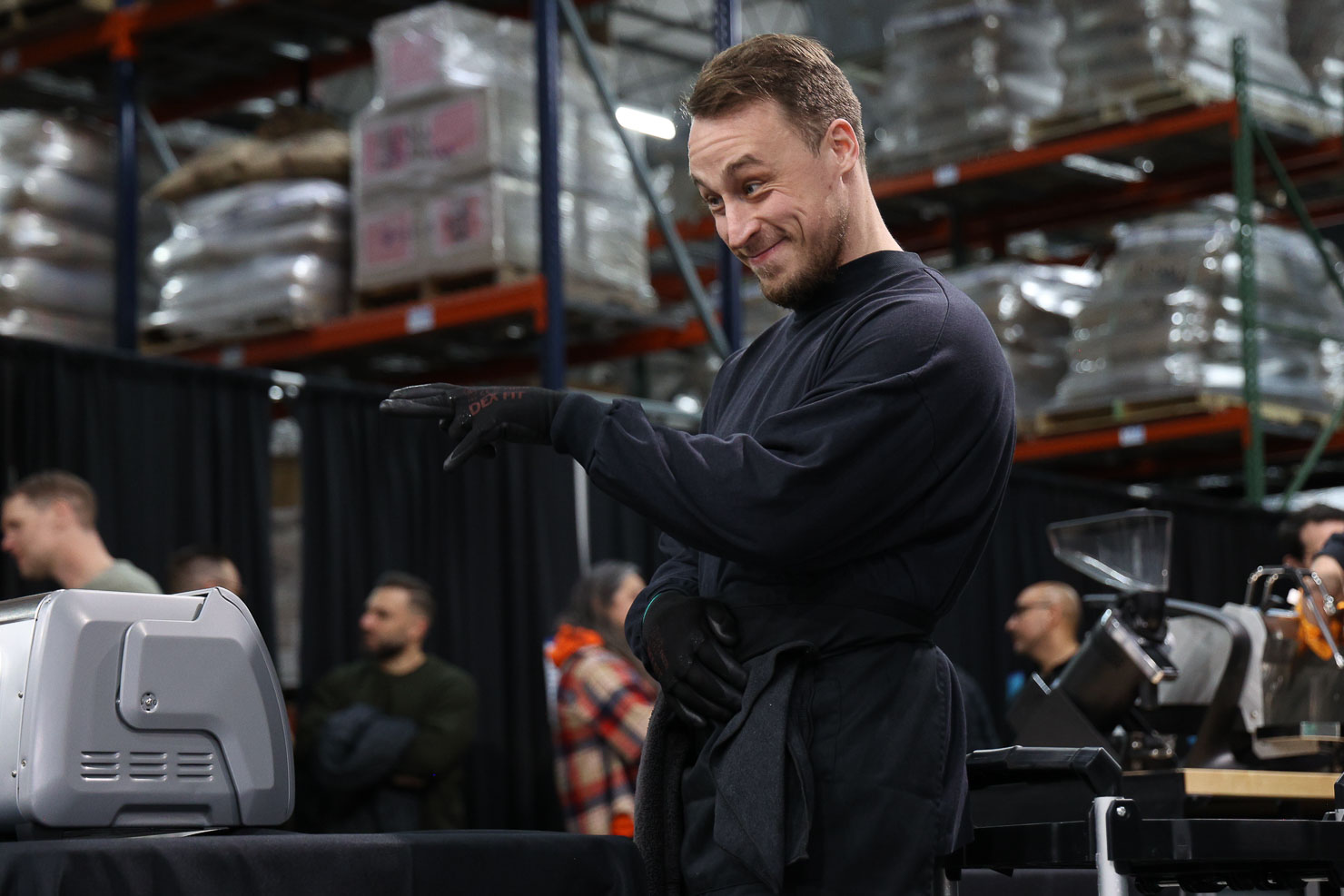
The Aussie invasion continues into the Semi-Finals with Jak Ryan Of Proud Mary Coffee in Austin, Texas. “Magic exists in two main forms: in nature… and in athletic or artistic pursuits.” Ryan competes an anaerobic fermented natural processed Gesha variety coffee known as Toña, grown at 1,750MASL in Boquete, Panama at Mama Cata by the Garrido family.
There’s been a lot of “cozy coffee shop music for studying” soundtrack vibes this year. No one’s taking any big swings with the playlist, and regrettably, no Tommy Cash and Espresso Macchiato. But Ryan, his soundtrack is taking swings. Big ‘80s swings. I’m not mad about it.
For the milk course, Ryan Incorporates a milk freeze-distilled to 50% of its original volume into the Mata Cata Gesha for notes of malt cookie, raw cashew, and panela sugar. As an espresso, Ryan’s Gesha tastes of strawberry, bergamot, and blackberry, with a slippery texture and malt chocolate finish.
Ryan describes Garrido as “someone you’d want to party with,” and I’m not saying there’s an Australian coffee person stereotype but…

The room fills with a cedar aroma emanating from Ryan’s sig bev. Cedar steeps in freeze-distilled milk and combines with a steam-distilled blueberry reduction-but-not-a-reduction. It all gets aerated and served over a cedar plank spritzed with hydrol, giving the beverage flavors of banana cream, candied ginger, and boysenberry.
Jake McFarland – Black & White Coffee – Raleigh, NC

Must be nice to be able compete for the US Barista Championship in the exact same place that you go every day for work. Maybe our next competitor will know, it’s Jake McFarland of 6651 Meridien Drive, otherwise known as Black & White Coffee Roasters HQ. The judges have been instructed to not drink any of McFarland’s beverages until he says, “In order to grow, we must be open to change.” Feels a little Pavlovian, no? “Judges, you’ll give me perfect scores. In order to grow, we must be open to change.”
McFarland’s coffee today is yeast-inoculated, thermal-shocked natural processed Pacamara variety from Bruselas, Colombia. To show how the thermal shock process affects flavor, McFarland gives the judges two blueberries: one normal and one thermal shocked. Pulled over frozen spheres, the Pacamara espresso has notes of juicy cherry, cara cara orange, a lilac florality, and a dark chocolate finish.
For the milk beverage, McFarland’s Pacamara expresses flavors of cooked cherry, marzipan, single origin dark chocolate that he says tastes something like a cherry cordial. For the sig bev course, McFarland hyper-chills the Pacamara and adds it to pineapple juice, coconut cream, and isoamyl acetate, presenting flavors of strawberry, marshmallow, coconut icing, bruleed banana, and single origin dark chocolate.
Gray Kauffman – Seattle, WA

Our next competitor is Gray Kauffman, an independent competitor out of Seattle. Kauffman is a multi-time Semi-Finalist, each time as an independent. It can’t be overstated how difficult the USBC is for competitors without the backing of a company, and yet Kauffman has done it time and time again. It’s kind of insane.
Kauffman is using an anaerobic fermented Gesha grown at 1,700MASL from La Palma y El Tucan in Colombia, that pulled at 17.5g in to 45 out over frozen spheres, their La Palma Gesha has notes of honeysuckle, meyer lemon, and white peach with an oolong tea finish.
The milk course, which Kauffman says “tastes like milk tea,” combines 90% lactose-free 2% milk and 10% coconut milk, and when steamed to 140F has notes of black tea, creamed honey, and white chocolate. Finishing off with the sig bev, Kauffman mixes chilled espresso with lacto-fermented blood orange juice, guava panela reduction, and a plum and rosehip tea, aerated and topped with a jasmine and mandarin orange peel aromatic fog for flavors of raspberry frozen yogurt and orange blossom.
These are completely new flavor calls for all of Kauffman’s courses, and once again my old coffee soul sings. This is the sort of barista’ing you can’t help but love to see.
Jason Yeo – Saint Frank Coffee – San Francisco, CA

Now up is veteran competitor Jason Yeo of Saint Frank Coffee, whose routine starts with our first technical timeout of the competition. “To be a master is to always be a student,” Yeo states. It will come as no surprise to anyone who has been following the USBC for a while that Yeo competes today with not one but two coffees produced by Benjamin Paz in Honduras. Going all the way back to the days of founder Kevin Bohlin’s comp days to Reef Bessette, Saint Frank competitors are never too from a Benjamin Paz coffee.
The first Paz coffee is a Green Tip Gesha from La Salsa in Santa Barbara, which has been anaerobically fermented in the coffee’s mucilage and then fully wash processed, and when pulled at 19.5g in to 45g out, it has notes of rainier cherry, tangerine, and dark chocolate. The second coffee is a classic Red Bourbon that has been natural processed. Pulled at a tighter 1:2 ratio and combined with a blend of freeze-distilled and evaporate lactose-free milk and cryodesiccated high butter fat milk sourced from Hokkaido, Japan, Yeo’s milk course has notes of white chocolate, butterscotch, and butter cookie.
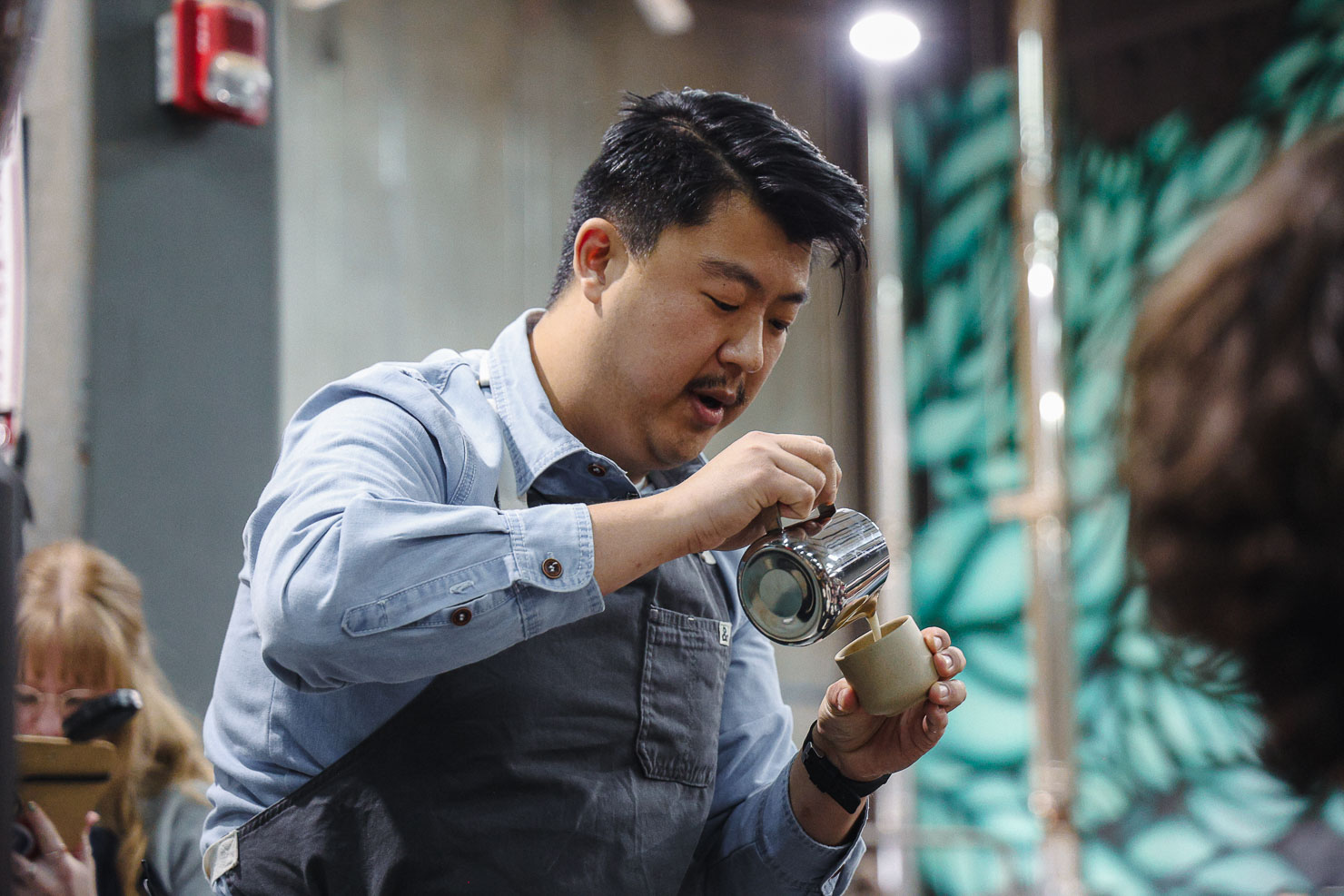
Lots of folks pulling much shorter shots for their milk courses this year, many way shorter than Yeo’s. These espressos are in a fight for their lives to punch through all the creaminess and palate coating from the goosed up fat content in the freeze-distilled and cryodesiccated milks. There is no course more in flux right now than the milk course.
For the sig bev, Yeo combines hyperchilled Red Bourbon, with “Gesha-like ingredients:” panela oleo saccharum, watermelon and hop milk punch, and mango and peach juice, giving it notes of jasmine, muscat green grape, orange juice, white gummy bears (the best gummy bear IMO).
Seidy Selivanow – Kafiex Roasters – Vancouver, WA

Now up is Seidy Selivanow from Kafiex Roasters in Vancouver, Washington. Selivanow competes today with a washed Sidra variety coffee grown by at 1,750MASL by Julio Madrid at Finca La Riviera in Risaralda, Colombia, 15 days off roast. Pulled at 18g in to 42g out, the Sidra espresso has flavors of grapes, tangerine, and orange blossom.
For her milk beverage, which Selivanow describes as “[creating] a bouquet of flowers in your cup,” a blend of 70% whole milk and 30% freeze-distilled milk gets combined with a shorter 18g:32g espresso for notes of bergamot, soft vanilla, and caramel. Finishing off with the sig bev, Selivanow adds chilled Sidra espresso to tepache, and papaya oleo saccharum, all of which get nitro infused and finished with an orange blossom air foam, creating flavor calls of orange blossom, passionfruit, ripe mango, guava, cinnamon, and warming spices.
Miranda Huncovsky – Moongoat Coffee Roasters – Costa Mesa, CA

Our next competitor is Miranda Huncovsky from Moongoat Coffee Roasters in Costa Mesa, California. Huncovsky is using a Caturra variety today, produced by Julio Madrid in Colombia. The name Julio Madrid has been said many, many times on the USBC stage this year. He’s the new Rigoberto Herrera or Jamison Savage or Lamastus family. All of their espressos today will be made using the same parameters: 17g in and 50g out in 20 second.
Judges are rolling dice to determine how many times they stir their espressos before drinking, giving the course an element of play that is the theme of Huncovsky’s routine today. This is a deeply interesting twist on the judges’ instructions, precision stirring being replaced by chance. Coffee can be fun. LET COFFEE BE FUN!
As an espresso, the Caturra has notes of watermelon, cantaloupe, and a jolly rancher sweetness. Then, when added to a 50/50 blend freeze-distilled whole milk and freeze-distilled koji rice milk, the flavors transform into cashew cream, dried apricots, and strawberry milk.
Sumo mandarin clarified milk, sumo mandarin oleo saccharum, “nature-cultivate” honey, and vanilla bean powder, all get nitro infused and served with rosemary infused water for Huncovsky’s sig bev, which has flavors of pine, mango sherbet, and lime zest.
Circle Chan – The Coffee Movement – San Francisco, CA

Now up is Circle Chan of The Coffee Movement in San Francisco. Chan is using an incredible blend for her comp coffee. It’s a 75% washed Panama Gesha from Volcan combined with 25% of a champagne yeast inoculated natural processed Kona Gesha grown at 740MASL and picked just one month ago. “It’s a great coffee to represent me because it has a low elevation.” This is a high-quality short joke. Just real top shelf stuff.
As an espresso pulled at 21g in and 50g out in 25 second and stirred with frozen spoons, it has notes of apricot, peach, lemon candy, and a jasmine blossom finish. In the milk course, Chan uses a blend of 85% cream-top milk freeze-distilled to 50% by weight and 15% macadamia nut milk, finished with a coconut milk powder, that, when steamed to 125F and combined in a 2:1 ratio with the Gesha blend, has notes of haupia (a Hawaiian coconut pudding), nougat candy, and rice pudding.

For her sig bev, Chan incorporates lactose syrup, coconut water with vanilla, and passionfruit puree that gets served with a sidecar component that contains baking soda such that when the two are combined, the drink carbonates. “Just like the Hawaiian volcano, my drink erupts.” Her sig bev has notes of cream soda, guava jelly, strawberry yogurt, and salted caramel. Chan finishes her routine by presenting each of the judges with a lei.
Hugo Cano – Amberson Coffee – Indianapolis, IN

Next up is Hugo Cano of Amberson Coffee in Indianapolis, Indiana. Cano is a coffee competition polyglot, having made it to the Finals in multiple disciplines, but the USBC is his main squeeze and it’s good to have him back. Cano competes today with a blend of two different coffees, both produced by Jamison Savage at Finca Deborah in Volcan, Panama, both Geshas grown at 2,000MASL. One is carbonically macerated and the other is a yeast-inoculated, which are combined at 30% and 70%, respectively.
As an espresso, pulled at 20g in to 42g out in 22 seconds over chilled spheres—with the cups lidded to further trap in the volatile aromatics until the judges are ready to drink them—the Gesha blend has notes of hibiscus, raspberry, dark chocolate, and a white flower florality. Turning to the milk beverage, Cano uses a shorter 1:1.5 shot with a blend of 10% caramelized pistachio milk and 90% lactose-free milk, which creates flavors of cherry cheesecake, toffee, and chocolate milkshake.
Ending with the signature beverage, Cano combines lacto-fermented pineapple juice, saccharomyces yeast-fermented cherry juice, and caramelized pistachio milk, all blended together for flavors of mandarin orange, mulled wine, malt, and Mexican hot chocolate.
Jamie Patel – Counter Culture Coffee – Durham, NC

Our last competitor of the Semi-Finals of the 2025 US Barista Championship is Jamie Patel from just down the way in Durham. Time truly does fly when you’re having fun. Patel’s coffee today is a Green Tip Gesha grown at 1,800MASL by Jose Gallardo at Finca Nuguo in Chiriqui, Panama. It’s the espresso course first, where Patel pulls his shots at 20g in to 25g out in 26 seconds. Stirred 10 times, they have flavors of black tea, sweet lime, and jasmine, with a long floral finish.
Patel goes shorter with the shots for the milk course, 21g to 40g out. Patel uses a 2:1 ratio of lactose-free milk freeze-distilled to 75% by volume to coconut milk that, when paired with the Green Tip Gesha, has notes of lemon curd, shortbread cookie, and butter toffee.
Our last course of the Semi-Finals is the signature beverage course. For it, Patel takes hyper-chilled shots of the shorter espresso from the milk course, adding to them gardenia tea, clarified milk, and a meyer lemon oleo saccharum to create new flavors of white flower bouquet, pineapple cream soda, and chocolate dust.
That’s it for today! Thanks for tuning in and we’ll see you tomorrow for the Finals of the 2025 US Barista Championship!
Sprudge’s coverage of the 2025 US Barista Championship in Raleigh, North Carolina is presented in by La Marzocco and Pacific Barista Series.

